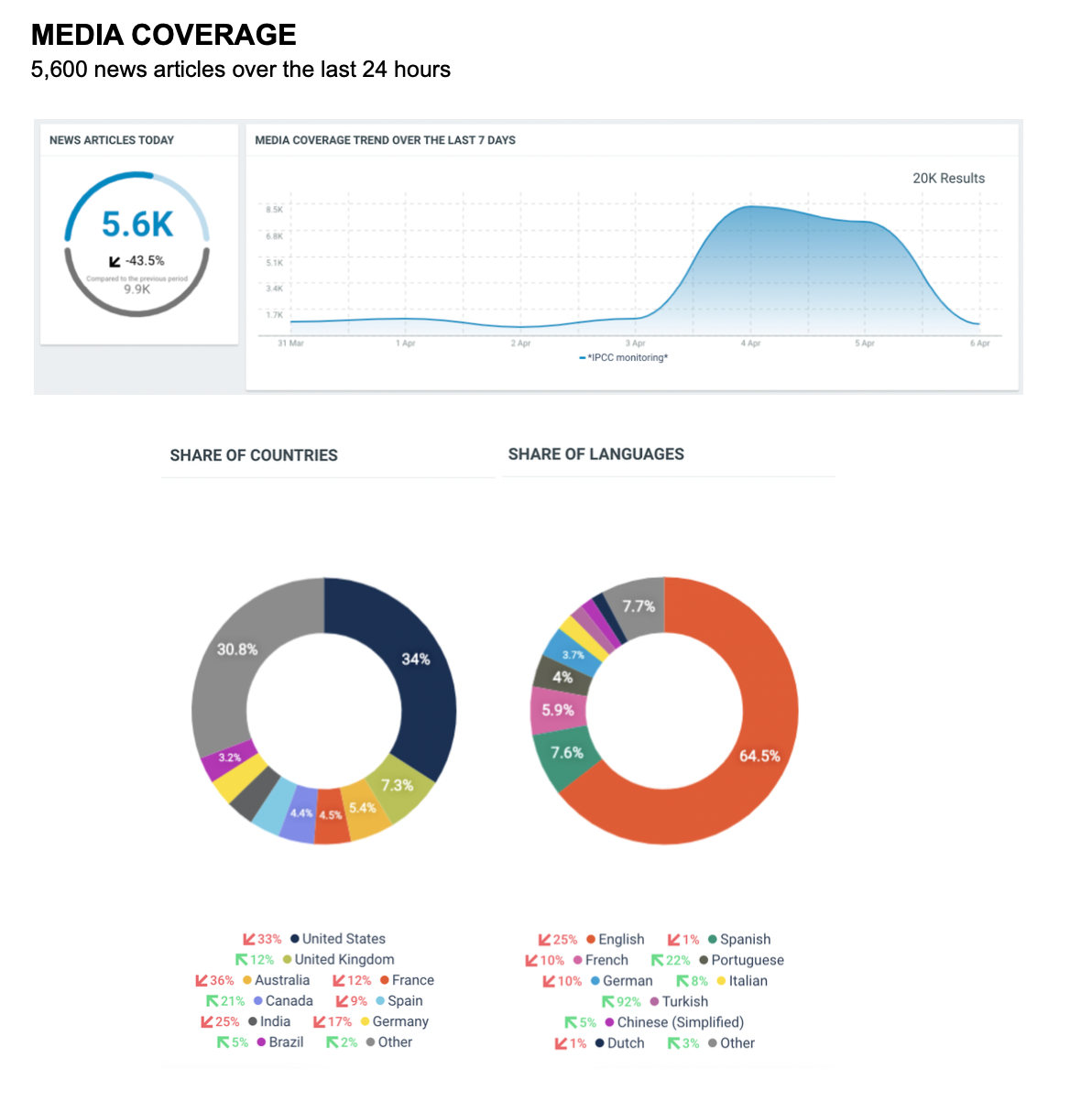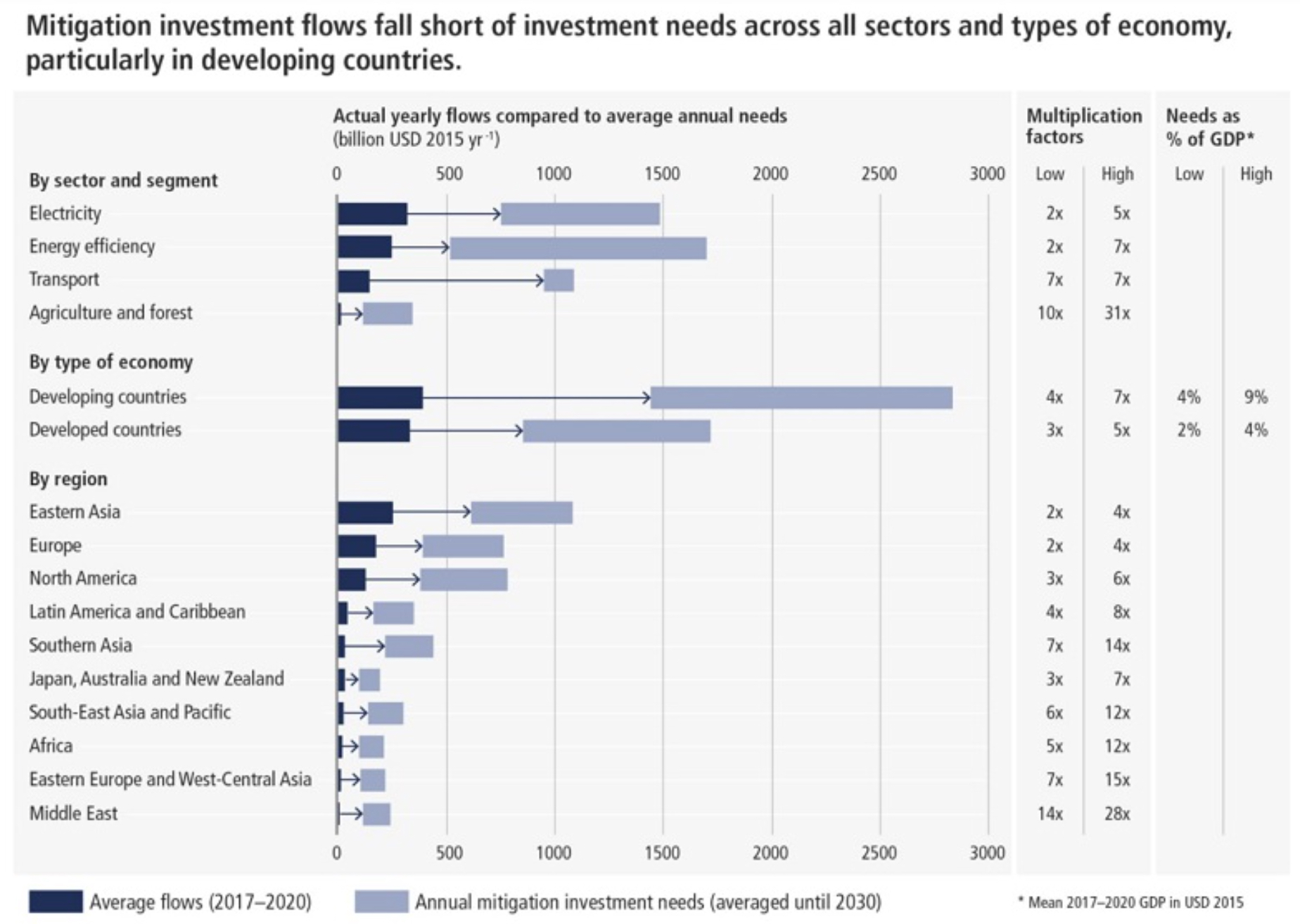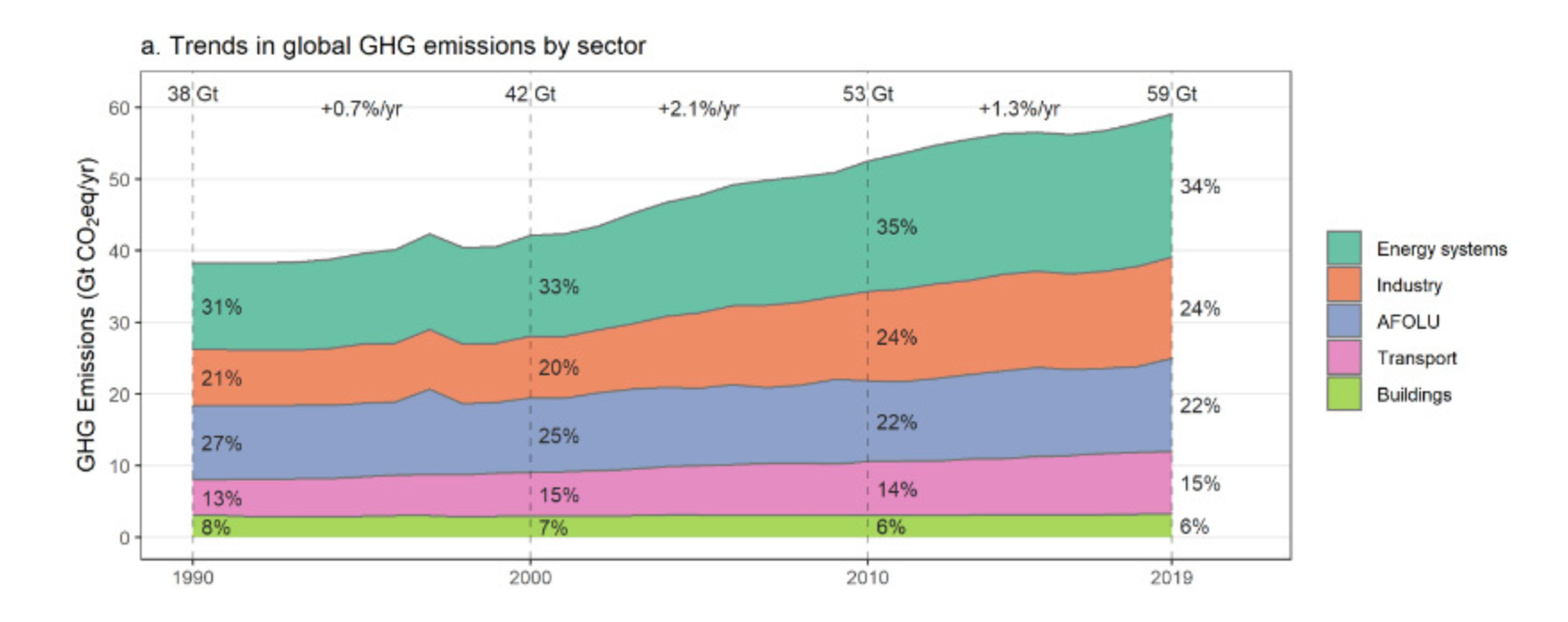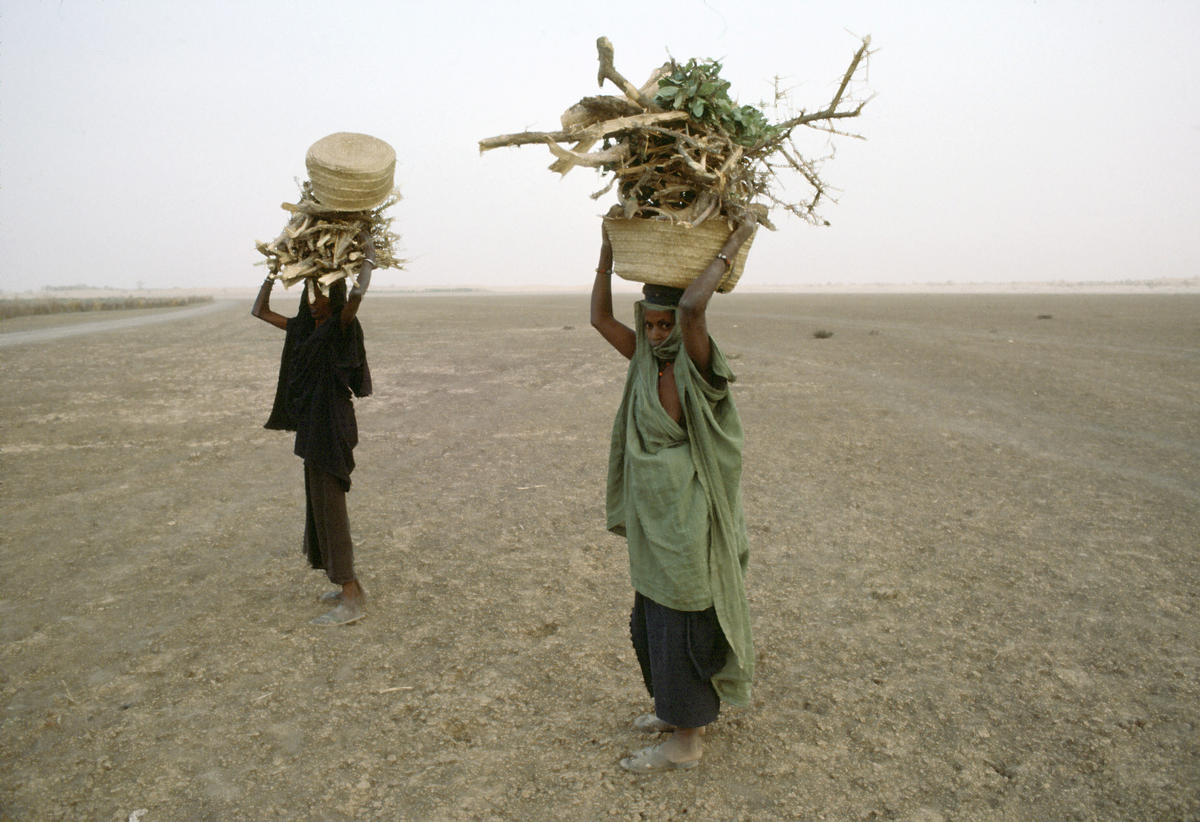The IPCC’s Working Group III report on Mitigation of Climate Change was published On Monday the 4th some 40 hours behind schedule as government delegations spent the last two weeks ironing out the details of the “summary for policymakers”, in what turned out to be the longest ever approval session, involving over 150 hours of virtual meetings.
Notwithstanding current media focus on the war in Ukraine and surging energy prices, global coverage of the report has been widespread with an overwhelming focus on the Report’s “now or never” call to action. In fact, the IPCC revealed in their media review newsletter that around 5,600 news articles featured mentions of the report in the 24 hours following its publishing.

Peak emissions and the science-policy dilemma
The WGIII report brings together an array of scientific evidence to bolster a series of clear messages on the need for urgent action. The first key takeaway is that there is a hugely uneven distribution in past and present greenhouse gas emissions between global regions and countries.
The second is that – once again – current and predicted emissions reductions will not be enough to put us on track for a global mean temperature rise of 1.5 degrees Celsius or less, as set out in the Paris agreement.
According to Ko Barrett, vice-chair of the IPCC and senior adviser for climate at NOAA, when speaking on the Outrage + Optimism podcast, the report clearly shows that emissions over the last decade were the highest in human history and that “we would need to peak emissions before 2025 and reduce greenhouse gas emissions by 45% by the end of the decade.”
In fact, Barrett points out how the timeframe for action in this report has shrunk when compared to the one laid out by the 1.5C report released in 2018, which originally gave mankind a larger window to enact the required changes. “The lack of time that we have to solve this problem is front and centre of the WGIII report […] if we are going to peak emissions in two or three years then there is no time […] the science tells us it is possible but questions remain about the political reality?”
The lack of adequate political action was also picked up on by UN secretary-general António Guterres whose video message for the launch of the report pulled no punches, claiming that the evidence presented in the report is a “file of shame, cataloguing the empty pledges that put us firmly on track towards an unlivable world.”
Harsh words that ring even stronger when coming from such a senior diplomatic figure: “Climate activists are sometimes depicted as dangerous radicals. But the truly dangerous radicals are the countries that are increasing the production of fossil fuels…[The report] sets out viable, financially sound options [for cutting emissions] in every sector that can keep the possibility of limiting warming to 1.5C alive.”
"We need to take action now or 1.5ºC will become out of reach, it will be physically impossible to get there." – #IPCC Working Group III Co-Chair Jim Skea at today’s press conference for the release of the latest #IPCC #ClimateReport on the mitigation of #climatechange. pic.twitter.com/EVouUNxaVQ
— IPCC (@IPCC_CH) April 4, 2022
In fact, after outlining the current predicament the true focus of the WGII’s report is on solutions, outlining a selection of technological, political and economic measures that have the potential to set us on course for decarbonisation and even halve emissions by 2030.
According to Barrett the report not only speaks to politicians but contains new information that can help individuals lower their impacts, which is important as: “IPCC reports have evolved to become a source of information not only for policymakers but also for the average person.”
From a focus on global cities and their role in fighting climate change, to the need for a rapid energy transition and the possible contribution of individuals and lifestyle choices on overall emissions, the WGIII report offers plenty of food for thought that different experts and observers around the world have jumped to comment, explain and analyze.
Global headlines
Global coverage of the final chapter of AR6 has been mixed with some national newspapers featuring the report on their front pages, whereas others chose to ignore it as other news stories took centre stage.
European newspapers in countries such as Germany, Spain and the UK locked in on the message of urgency. In the Spanish daily El Pais, climate expert Manuel Planelles talks about different emissions reductions scenarios and how these will impact global temperatures.
He then goes on to link the report to current geopolitical issues, addressing how the war in Ukraine will affect emission reduction strategies as well as impact energy consumption habits, concluding with a focus on the economic benefits of an energy transition laid out in the report, which shows how in most scenarios exceed the costs of mitigation.
Linking economic benefits to a green transition is also a common theme in the British Daily, The Guardian, which published numerous articles on the report including a frontpage headline reading: “It’s now or never to prevent the worst of the climate crisis”. In fact, British newspapers focused overwhelmingly on the issue of urgency which also featured in articles by the BBC.
In contrast, coverage of the report was disappointingly low in France and Italy where few newspapers dedicated front page stories choosing instead to concentrate on the war in Ukraine and rising energy prices.
A missed opportunity as the link between soaring energy prices and climate change was a common topic discussed in pieces such as the one written by Fiona Harvey for The Guardian, where she explains that – notwithstanding the warnings against ramping up fossil fuels contained in the report – “Soaring energy prices and the war in Ukraine have prompted governments to rethink their energy policies. Many countries – including the US, the UK and the EU – are considering ramping up fossil fuels as part of their response.”
🇬🇧 'It's Now Or Never' If The World Is To Stave Off Climate Disaster – IPCC
▫Emissions must peak by 2025 to have a chance of limiting heating to 1.5c
▫@fionaharvey▫https://t.co/neAH5ONKD4 🇬🇧@guardian #frontpagestoday #UK 🗞 pic.twitter.com/Q1xeb37hP2— 𝙵𝚛𝚘𝚗𝚝 𝙿𝚊𝚐𝚎𝚜 𝚃𝚘𝚍𝚊𝚢 📰 (@ukpapers) April 5, 2022
Outside of Europe the areas of focus taken by newspapers differed considerably. In India the main English language daily, The Hindu, featured numerous articles on the report with one front-page opinion piece on Monday the 4th dedicated to the need to revamp the Indian energy sector.
Deputy Science Editor Jacob Koshy chose to give space to the implications this will have for India which currently “has about 211 GW of operational coal-fired power plants — roughly 10% of global capacity.”
Koshy also emphasized the need for international cooperation, quoting the Indian environment Minister Bhupender Yadav as saying that: “India firmly believes that climate change is a global collective action problem that can be solved only through international cooperation and multilateralism,” which goes hand in hand with scaling up climate finance.
Similar issues featured in Brazilian newspapers, as well as references to the future role of cities in climate change mitigation strategies – often linked to discussions of the vulnerability of cities such as the capital, São Paulo, to heatwaves – a topic which is particularly pertinent in Latin America where there is a high concentration of mega cities.
The issue of cities is also discussed by Xuemei Bai, lead author on urban systems and other settlements when talking to The Conversation. Bai reveals how “the IPCC report found around 70% of the world’s greenhouse gas emissions are produced in cities and urban areas. This offers both challenges and opportunities for emissions reduction.”
The landmark report is a comprehensive catalogue of what can be done – but has mostly not yet been done – to avert devastating climate change.@t_wiedmann @Peters_Glen @xuemeibai_aus @UNSW @Sydney_Uni @SydneyUni_Media @ANUmedia @unimelb @uommedia#IPCChttps://t.co/SHHkAlbU3K
— The Conversation (@ConversationEDU) April 5, 2022
In Africa coverage of the report was not as widespread although most articles chose to address the issue of climate justice. “This important report on mitigation emphasizes the urgency of acting on mitigation, globally. For South Africa, we take a developmental approach to climate action, and this report provides valuable scientific information to guide our Just Transition,” Minister of Forestry, Fisheries and the Environment, Barbara Creecy, is quoted as having said on Tuesday.
“In the context of this report, issues of Climate Justice have never been more compelling. As we transition our energy generation and at least seven sectors of our economy, we are encouraged to see the IPCC report highlights a growing number of just transition commissions, laws, institutions, and processes,” continued the Minister when talking to SANews.gov.
As with previous reports, national newspapers have tended to focus on the issues that most affect their home countries whilst also addressing the do or die element that features so strongly in the report.
Civil society weighs in
Aside from global media coverage, civil society representatives have also been quick to weigh in on the report’s findings with many tackling the contentious issues of carbon capture and storage (CCS) technologies, climate justice and the efforts of some countries to weaken the summary for policymakers’ text.
A detailed Twitter feed by Brandon Wu, Director of Policy & Campaigns at ActionAidUSA, highlights how the US and developed countries worked to water down the summary for policymakers via ongoing attempts to shift responsibility for climate change onto the Global South, in particular with reference to removing references to equity, climate justice, the 100 billion USD goal, and differentiation between responsibilities of developed and developing countries.
An issue that was also picked up by Climate Home News reporter Chloe Farand, whose article reveals how different countries lobbied for certain omissions in the final text.

Farand’s article also looks at Saudi Arabia’s emphasis on CCS as a climate solution that keeps the oil industry alive longer: “Saudi Arabia, one of the world’s largest oil producers and exporters, successfully argued for the repeated inclusion of references to CCS, which remains unproven at commercial scale. Opposition from European nations wasn’t enough to prevent a weakening of language on the need to phase out coal, oil and gas.”
In reference to these instances of negotiations on the summary for policymakers, Wu criticizes the huge emphasis on CCS, pointing out that although the full WGIII report is a summary of scientific knowledge, the summary for policymakers is the product of negotiation between scientists and politicians.
Yet not all think this is necessarily a bad thing. According to Prof. Jean-Pascal van Ypersele this process of negotiation is both necessary and productive whereby “strong, and sometimes tense discussions between country delegates and the authors [of the report] have a big advantage over a report that would be written by scientists alone, in their ivory tower: a common sense of ownership.”
Some criticise this process involving the policymakers in the #IPCC work. They should remember that the scientists authoring the report always have the last word on what is in the SPM, even if they don’t on what is not in it, because we work by consensus.
— Prof. Jean-Pascal van Ypersele (@JPvanYpersele) April 3, 2022
The issue of CCS is possibly one of the most contentious topics to come out of the report, leading to a wide array of reactions. Climate scientist Zeke Hausfather, outlines why he believes that the report does a good job in highlighting why “We need to accelerate the deployment of mature clean energy technologies and behavioral shifts this decade even as we work to develop the technologies we will need for the next few.”
In contrast, speaking during a live webinar hosted by the Fossil Fuel non Proliferation Initiative, Carroll Muffet, from the Center for International Environmental Law, claims that: “when you get into the technical details you see that reliance on CCS approaches will push us beyond 1.5 degrees […] yet in the summary for policy makers there is a recurring effort to mask that core scientific reality and argue that we need CO2 removal to respond to the climate crisis. However, that is only true if we don’t immediately start to phase out the fossil fuels that are responsible for the crisis […] these false solutions are not buying us additional time but risk derailing workable solutions such as renewables and electrification.”
When speaking to The Conservation, Tommy Wiedmann, an IPCC lead author and professor of sustainability research at UNSW Sydney in Australia, explains that: “Technology is not a silver bullet. To have a chance of halving global emissions by 2030, we must use fewer high-carbon products and adopt less emissions-intensive lifestyles. Like all other changes required, these cannot be incremental.”
However, carbon dioxide removal is not only about technological solutions but also nature based solutions such as tree planting and soil carbon sequestration. According to Barrat, “Carbon dioxide removal both with nature and technology is something that features in every scenario if we surpass 1.5C warming [..] Although the unproven nature of being able to scale up these technological fixes is true, it is also really very clear that we need them to reach net zero.”

Now or never
The main takeaways from global reactions to the new IPCC Report are that we are on course to overshoot 1.5C; coal and gas have to be left in the ground if we are to have any chance of meeting the Paris Agreement goals; there are solutions available – most notably renewables – and they are getting cheaper (in fact the economic benefit of limiting warming to below 2C is higher than the cost of action); there is an irrefutable need for carbon dioxide removal; and finally lifestyle changes are part of the solution to climate change.
In his opinion piece published in The Washington Post Guterres is extremely critical of current global efforts: “The science is clear. To keep the 1.5-degree limit within reach, we need to cut global emissions by 45 percent this decade. But current climate pledges would mean a 14 percent increase in emissions. And most major emitters are not taking the steps needed to fulfill even these inadequate promises.”
When commenting the report Saber Chowdry, Member of Parliament in Bangladesh, chose to emphasize how the focus on mitigation is necessary as our ability to adapt is being outrun by climate change: “if you look at the whole UNFCCC discourse it started off with mitigation, then we moved to adaptation and we have now realized that you simply can’t adapt fast enough because there are natural limits to adaptation […] We need to tackle decarbonisation.”
The shift from a focus on adaptation to mitigation was also echoed by The New York Times, whose opinion piece on the report focuses on the fact that “The dangers of climate change are mounting so rapidly that they could soon overwhelm the ability of both nature and humanity to adapt.”
Guterres’ opinion piece concludes by outlining the need to transition to renewables, identifying the energy transition as a major source of benefits in mitigating emissions and hence tackling climate change: “Demand an end to coal-fired power. Call for renewable energy to be deployed rapidly and widely. A shift to renewables will mend our broken global energy mix and offer hope to millions of people already suffering from the impact of climate change,” he concludes.






